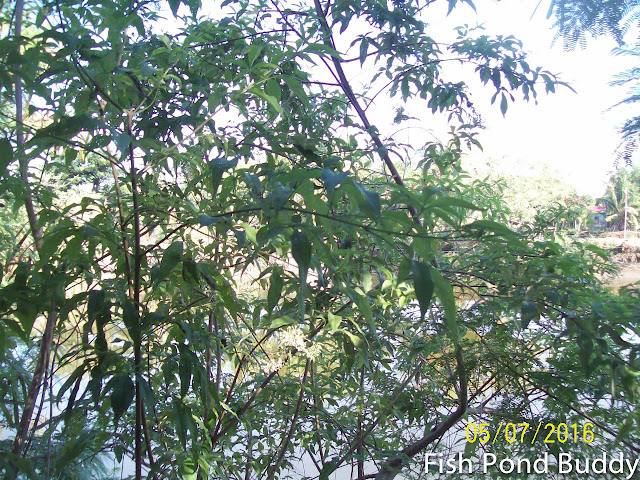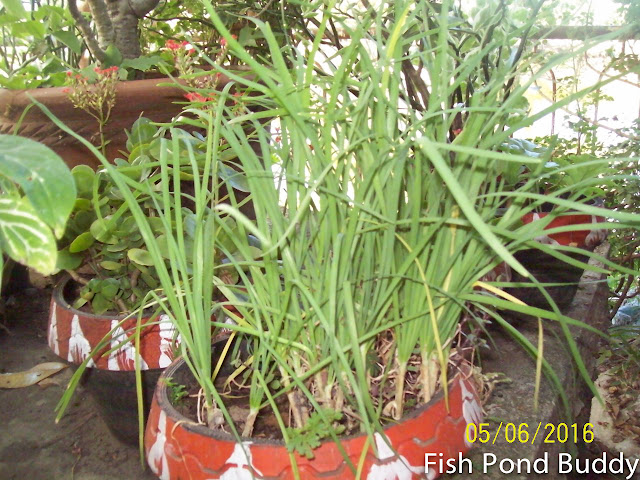Common Medicinal Plants, Fruits, Trees in the Fish Farm
Most rural folks in our farm village have access to basic health care, medical consultation or even hospitalization.
A few hundred meters away is a barangay (village) health center staffed by a nurse and health workers. Also a bigger health center at the town proper with doctors and nurses.
For hospitalization or child birth, they go to the provincial hospital in San Carlos City or the regional hospital in Dagupan City. Both hospitals often give free doctor’s and hospital services, except medicine (which can be bought at reduced prices if one is indigent). For child birth, there are lying-in clinics in the village. Pls. see also my blog post on "How My Fish Farm Overseer's Niece Gave Birth to her Newborn for Free!".
For simple illnesses, such as headaches, colds, cough, body pains, etc., low-priced generic or even branded over-the-counter drugs are available at the local drug stores.
Yet, rural folks often tend to turn to medicinal plants, fruits, and trees to cure common illnesses. When they get sick, the younger ones seek advice from their elders who prescribe herbal treatment just as their ancestors did. Plants, trees, or fruits which can relieve or treat illnesses are just around the house, as they say.
“Eat this fruit, boil this bark and use it for bathing, drink this tea, pound these leaves into a paste and apply on your sore body, etc…..”
My "hilot" (local massage therapist) like Ka Virgie, is herself a strong advocate of herbal medicine. Click this to see my blog post on "Traditional Healing in the Fish Farm". She uses indigenous plants and trees commonly found in the farm and around the village.
Before our "hilot" session, Ka Virgie, my farm overseer, her visiting mother, and my assistant caretaker talked about herbal treatment of common illnesses. So I asked them which medicinal plants and trees are most popularly used in Pangasinan.
Here are the most used medicinal plants that they mentioned and the common uses (not meant to be a complete list but will add to them later). Note: some photos are not yet available.
1. Blumea camphor ("sambong" in Tagalog) (“subusob” in Ilocano) - pick some leaves, boil them, and drink as herbal tea. It will relieve pain when urinating. Also lowers blood pressure. Photo to follow.
2. Guava (“bayabas”) - get young shoots, put on a banana leaf, add oil, fold banana leaf, heat over ember on stove for 2 minutes. This is applied to the affected area to relieve contusions, muscle and joint pains, even arthritis. Another method is to pound fresh banana leaves in mortar and pestle and resulting poultice is used as in above.
 |
| Guava tree with its leaves |
3. Five-leaved chaste tree ("lagundi" in Tagalog) (“dangla” in Ilocano) – boil chopped leaves (half cup) in water and drink half cup 3 times daily to relieve cough, colds, fever, flu, asthma.
 |
| Lagundi tree with its leaves beside our Main Pond |
4. Lemon grass (“balanoy”) – get roots, clean and wash them, boil, and massage the chest to relieve chest pain or feeling of chest congestion. Photo to follow.
5. Fragrant premna (“alagaw” in Tagalog) (“agdao” in Pangasinense) – get 4 leaves, warm them over ember in stove, apply coconut oil on the leaves, and apply over temples and forehead to relieve headache.
 |
| Alagao tree with its leaves growing on the south dike of our Main Pond |
6. Black honey shrub (“malatinta” in Tagalog and Pangasinense) – boil the leaves in a pot with water, take out the leaves, and wash the body with the boiled liquid to alleviate allergy or itchiness.
 |
| A malatinta shrub which I grew on a pot in our garden. Normally found growing wildly in the vicinity like weeds |
7. Avocado - boil the leaves, pour liquid over strainer into a cup, then drink to relieve diarrhea.
 |
| Avocado tree with its leaves in front of our farm house |
 |
| A large acacia tree in a neighboring pond next to ours |
9. Chives (“kusay”) – warm the leaves over firewood ember, apply coconut oil on the leaves, and massage over spinal column to relieve body pain.
 |
| A clump of chives plants in a rubber pot outside our farm house |
10. Turmeric (“luyang dilaw”) – for swelling due to sprain, pound using mortar and pestle, add coconut oil and apply on swollen part. Photo to follow.
11. Camachile (“kamatsile” in Tagalog) (“kamantilis” in Pangasinense) – eat the semi-ripe fruit to lower high blood sugar. Photo to follow.
12. Java plum (“duhat” in Tagalog), (“lomboy” in Pangasinense) – boil the bark and drink the liquid to lower high blood sugar.
 |
| A duhat tree growing beside our outdoor cooking shed |
13. Cucumber Tree ("kamias" in Tagalog) – boil the leaves and pour into a plastic basin. Add enough water to make it lukewarm. Use the liquid to bathe a sick child.
 |
| A kamias tree with its leaves at the back of our farm house |
14. Papaya – is cure for appendicitis. Early morning, eat the ripe fruit including seeds. Photo to follow.
15. Star apple (“kaimito”) – eat the fruit to relieve diarrhea.
 |
| A star apple tree. We don't have our own, but a neighbor has one as shown above |
16. Moringa (“malunggay”) – boil the leaves only, plain, nothing added. Drink the liquid with the leaves. It’s best for cleaning up one’s intestines.
 |
| One of several moringa trees in our ponds. This one overlooks our main grow-out pond. |
17. Coconut (“niyog”) – drink the coconut water before breakfast. Good for kidneys. Don’t drink with a full stomach, it becomes less effective. Also don’t drink when very tired or very hungry.
 |
| A coconut tree with its fruits at the middle (beside our bamboo farm hut at the right) |
18. Pineapple (“pina”) – let a child eat the fruit to expel intestinal worms; eat fruit to promote bowel movement. Photo to follow.
19. Banana (“saging”) – use young shoots (also called "suckers"), put over tummy to relieve gas pain. See the shoot become shriveled.
 |
| A clump of banana plants at the south dike of our Main Pond; the shoot or "sucker" is the young stem growing beside the main trunk of the plant; if allowed to grow, it will become a mature plant. |
20. Onion (“sibuyas”) – heat the young onion called “lasona” over stove ember, mix with coconut oil, and apply over tummy area to relieve gas pain.
 |
| A basket of onions |
21. Tamarind (“sampalok”) – boil the leaves, pour the liquid including leaves into a plastic basin. Mix with enough tap water to make it lukewarm. Use as bath (“banos” in Pangasinense) for fever, after child birth, and after an illness.
 |
| Sampaloc tree leaves |
22. Bignay – boil the leaves, pour the liquid into a glass over a strainer. Drink the liquid to lower blood sugar level.
 |
| A young bignay tree near our bamboo shed |
23. Bitter gourd or bitter melon (“ampalaya” in Tagalog) – get the leaves, mix with the white of an egg. Massage on the forehead, nape and back (but not on the chest) to relieve high fever. Photo to follow.
24. Anonas – bark is a strong hex (“kulam”) shield. Wear it as a belt or bracelet.
25. Neem tree - boil the leaves, pour the liquid into a glass over a strainer. Drink 2 glasses to relieve diarrhea. Used also to normalize menstrual flow.
 |
| Neem tree leaves |
26. Cassava ("kamoteng kahoy", "kahoy" in Pangasinense) - use the leaves as poultice for fever and headache; eat the root crop to relieve ulcer and use same as poultice applied on wounds. Photo to follow.
27. Sweet Potato ("kamote") - eat leaves to lower blood sugar, tuber to stimulate bowel movement or apply leaves as poultice on wounds, even pimples. Photo to follow.
28. Tomato ("kamatis") - eat the fruit to relieve asthma or apply on skin burns caused by oil splatters while cooking. Photo to follow.
29. Philippine Lime or Calamondin ("kalamansi") - use leaves with others for warm herbal bath (see my blog post on "Traditional Healing in the Fish Farm"; use squeezed juice of fruit to dry pimples; rub fruit halves into armpits to eliminate underarm odor (much better than commercial deodorants).
 |
| A calamansi tree near our manual water pump |
30. Guyabano - boil leaves and drink as your daily tea as remedy for various illnesses (I drink this myself). For oily skin, apply juice from the fresh meat of fruit on face.
 |
| Guyabano tree, leaves and a young fruit beside our farm bamboo shed |
31. Dalanghita - squeeze fresh rind and smell to relieve one from nausea caused by motion sickness. I like squeezing two pieces of the fruits and mix it with powdered juice in a large glass of water (with ice but no sugar). Stir and drink - will prevent colds.
 |
| Our dalanghita tree with its fruits |
32. Atis - don't throw the hard seeds after eating the fruit. Grind or crush them, then mix with coconut oil and apply on your young daughter's scalp. They say it's good for removing hair lice ("lisa").
 |
| A young atis tree which already bore fruits |
33. Kangkong - tender tops are not only popular as boiled veggie soaked in shrimp paste with vinegar to be eaten with fried fish. Also eaten to promote vowel movement. It's also believed that when eaten, kangkong tops lower high blood sugar.
 |
| Kangkong growing at the side of one of our ponds |
34. Mango ("mangga") - eat the fruit to relieve indigestion and constipation. Use the dried powdered leaves to lower blood sugar.
35. Katuray (Corkwood tree)(sesbania grandiflora) - we use the juice from flowers for curing headache. Some neighbors think that the flowers lower blood pressure, although this may be anecdotal.
 |
| A katuray tree leaning toward our main grow-out pond. It bears white flowers which are also used as veggie ingredients for certain mongo-based dishes, aside from their medicinal use. |
36. Saluyot - used to relieve fever. Chop the washed fresh leaves of the plant into small pieces, put in a pitcher, add boiled water then let stand for about 10 minutes. Add a little sugar, stir then strain. Drink a glass every eight hours to relieve fever.
 |
| Saluyot leaves already picked. Not only are these used medicinally, the leaves are popularly used for veggie dishes. |
 |
| A saluyot plant growing near our fence |
For a complete list of Fish Pond Buddy blog posts on fish farm-related topics, please click the Index page.

No comments:
Post a Comment